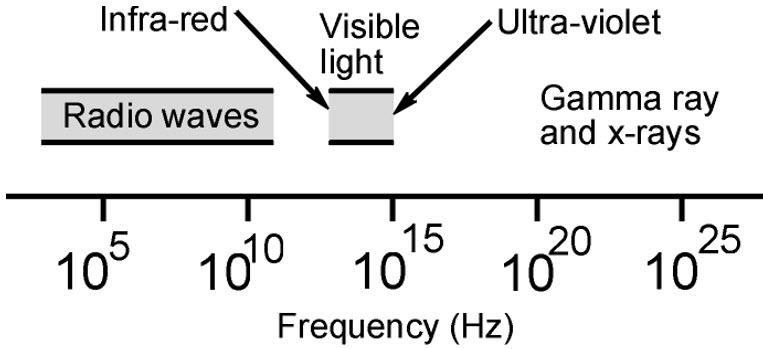An overview of the different areas of the radio spectrum the types of radio transmissions or broadcasts that they contain
Radio waves are one form of electromagnetic radiation. They have the lowest frequency, and hence the longest wavelengths. Above the radio spectrum, other forms of radiation can be found. These include infra red radiation, light, ultraviolet and a number of other forms of radiation. Although they have different names, and they are often thought of as different entities, they are all forms of electromagnetic wave. The only fundamental difference is the wavelength / frequency. As a result of this difference they act in slightly different ways, and they may be used for different purposes. For example infra-red radiation may be used for heating, while light is used for illuminating areas and visibly seeing things. Nevertheless they are all fundamentally the same.
The different types of electromagnetic wave and their relative frequencies and wavelengths may be displayed on what is often termed the electromagnetic spectrum. This covers radio waves at the lower end with the lowest frequencies and longest wavelengths to infra-red, light and ultraviolet radiation and extending further up in frequency to radiation such as gamma and x-rays.

While the whole of the electromagnetic wave spectrum covers a huge range of frequencies, radio waves themselves extend over a very large range as well. Again it is useful to be able to easily refer to different sections of the spectrum. To achieve this different designations are given to different areas. The frequencies that are covered are split into sections that vary by a factor of ten, e.g. from 3 MHz to 30 MHz. Each section is allocated a name such as high frequency and these areas are abbreviated to give terms like HF, VHF and so forth that are often used. Often talk is heard of VHF FM, or UHF television. The VHF and UHF refer to the areas of the radio spectrum where these transmissions take place

The radio spectrum
It can be seen from the diagram that transmissions in the long wave broadcast band which extends from 140.5 to 283.5 kHz available in some parts of the world falls into the low frequency or LF portion of the spectrum. There are also a number of other types of transmission which are made here. For example there are a number of navigational beacons which transmit on frequencies around 100 kHz or less.
Moving up in frequency, the medium wave broadcast band falls into the medium frequency or MF portion of the spectrum. Above this broadcast band is often where the lowest frequency short wave bands start. Here there is an amateur radio band together with allocations for maritime communications.
Between 3 and 30 MHz is the high frequency or HF portion. Within this frequency range lie the real short wave bands. Signals from all over the world can be heard. Broadcasters, radio amateurs and a host of others use them.
Moving up further the very high frequency or VHF part of the spectrum is encountered. This contains a large number of mobile users. “Radio Taxis” and the like have allocations here, as do the familiar VHF FM broadcasts.
In the ultra high frequency or UHF part of the spectrum most of the terrestrial television stations are located. In addition to these there are more mobile users including the increasingly popular cellular telephones.
Above this in the super high frequency or SHF and extremely high frequency or EHF portions of the spectrum there are many uses for the radio spectrum. They are being used increasingly for commercial satellite and point to point communications.







